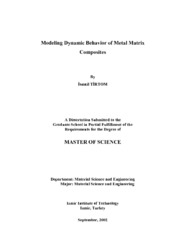Please use this identifier to cite or link to this item:
https://hdl.handle.net/11147/3696Full metadata record
| DC Field | Value | Language |
|---|---|---|
| dc.contributor.advisor | Güden, Mustafa | en |
| dc.contributor.author | Tirtom, İsmail | - |
| dc.date.accessioned | 2014-07-22T13:52:10Z | - |
| dc.date.available | 2014-07-22T13:52:10Z | - |
| dc.date.issued | 2002 | en |
| dc.identifier.uri | http://hdl.handle.net/11147/3696 | - |
| dc.description | Thesis (Master)--Izmir Institute of Technology, Materials Science and Engineering, Izmir, 2002 | en |
| dc.description | Includes bibliographical references (leaves: 73-76) | en |
| dc.description | Text in English; Abstract: Turkish and English | en |
| dc.description | x, 84 leaves | en |
| dc.description.abstract | A numerical investigation has been conducted on the strain rate dependent compression mechanical behavior of a SiC-particulate reinforced Al (2024-O) metal matrix composite. The effect of particle volume fraction on the strain rate sensitivity of the composite was determined using axisymmetric Finite Element unit cell models, where the particles are treated as elastic spheres embedded within a visco-plastic matrix, implemented in LUSAS Finite Element Analysis program. Particles are taken to be elastic, equal-sized, spherical and uniformly distributed in the matrix. The strain rate dependent constitutive behavior of the matrix material uses a linear relation between stress and strain rate formulation and is obtained from independent experimental results on the matrix. The flow stress of the composites is predicted over a range of strain rates for different particle volume fractions. Numerical results of the flow stress and strain rate sensitivity of the composite were also compared with those of experimental results, for 15% SiC particle reinforced 2024-O Al metal matrix composite. Influence of particle shape on the behavior of the MMC at high strain rates is also investigated. A unit cell, which is an elastic cylinder embedded within a visco-plastic matrix, is used. It is also shown that the rate dependent flow stress and local stress in the microstructure are influenced by particle shape. If reinforcement edge sharpness increases, local stress increases at that area. The results show that both the flow stress and the strain rate sensitivity increase with increasing volume fraction of the reinforcement due to the constraining effect of the reinforcement. Numerical calculations have shown an increased strain rate sensitivity of the composite over the matrix alloy. The discrepancy found between numerical and experimental results was finally discussed based on geometrical and microstructural parameters that might affect the composite flow stress and strain rate sensitivity. | en |
| dc.language.iso | en | en_US |
| dc.publisher | Izmir Institute of Technology | en |
| dc.rights | info:eu-repo/semantics/openAccess | en_US |
| dc.subject.lcc | TA481. T57 2002 | en |
| dc.subject.lcsh | Metalic composites | en |
| dc.subject.lcsh | Finite element method | en |
| dc.title | Modeling dynamic behavior of metal matrix composites | en_US |
| dc.type | Master Thesis | en_US |
| dc.institutionauthor | Tirtom, İsmail | - |
| dc.department | Thesis (Master)--İzmir Institute of Technology, Materials Science and Engineering | en_US |
| dc.relation.publicationcategory | Tez | en_US |
| item.languageiso639-1 | en | - |
| item.fulltext | With Fulltext | - |
| item.openairecristype | http://purl.org/coar/resource_type/c_18cf | - |
| item.openairetype | Master Thesis | - |
| item.grantfulltext | open | - |
| item.cerifentitytype | Publications | - |
| Appears in Collections: | Master Degree / Yüksek Lisans Tezleri | |
Files in This Item:
| File | Description | Size | Format | |
|---|---|---|---|---|
| T000141.pdf | MasterThesis | 1.66 MB | Adobe PDF |  View/Open |
CORE Recommender
Page view(s)
170
checked on Jul 22, 2024
Download(s)
132
checked on Jul 22, 2024
Google ScholarTM
Check
Items in GCRIS Repository are protected by copyright, with all rights reserved, unless otherwise indicated.